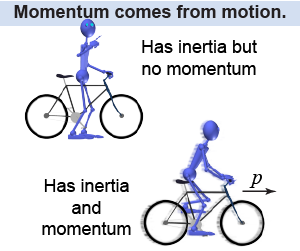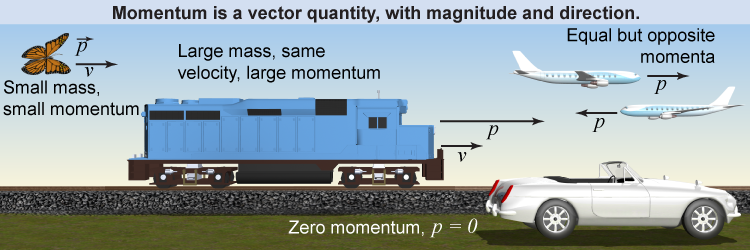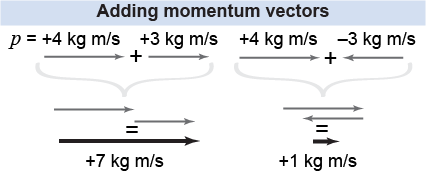|
In everyday language, a speeding train might be described as having a lot of inertia—or a lot of momentum. The terms inertia and momentum are often used interchangeably to describe a moving object that is difficult to stop. 
|
 In physics, inertia and momentum have distinct meanings, but they sometimes overlap. Inertia is a property of an object that is dependent on the object’s mass alone—it is an object’s resistance to change in velocity. A bicycle has the same inertia whether it moves at 10 m/s or is stationary. It does not, however, have the same momentum in both cases. Since momentum depends on both mass and velocity, momentum will be greater when the bicycle is moving at 10 m/s than when it is stationary.
In physics, inertia and momentum have distinct meanings, but they sometimes overlap. Inertia is a property of an object that is dependent on the object’s mass alone—it is an object’s resistance to change in velocity. A bicycle has the same inertia whether it moves at 10 m/s or is stationary. It does not, however, have the same momentum in both cases. Since momentum depends on both mass and velocity, momentum will be greater when the bicycle is moving at 10 m/s than when it is stationary. 
|

|
Momentum is the product of mass and velocity, and since velocity is a vector quantity, momentum is a vector quantity too. As a vector, momentum has both magnitude and direction. A fluttering butterfly will have a small momentum because its mass is small. A train, traveling at the same velocity, will have much more momentum than the butterfly because its mass is greater. In the illustration above, the train’s momentum vector is therefore drawn much longer than the butterfly’s. The two airplanes in the figure have momentum vectors pointing in opposite directions because their velocities are in opposite directions. A stationary car has a momentum vector of magnitude zero. 
 |
In the illustration above, the momentum vectors of the airplane were drawn in opposite directions. Alternatively, we could have expressed one airplane as having positive momentum and the other as having negative momentum! 
|
 Momentum vectors add in the same way as any other vectors we’ve encountered. As we learned on page 72, vectors can be added in one dimension and in more than one dimension. The figure on the right presents an example of graphical addition of vectors in one dimension. Adding = +10 kg m/s to
Momentum vectors add in the same way as any other vectors we’ve encountered. As we learned on page 72, vectors can be added in one dimension and in more than one dimension. The figure on the right presents an example of graphical addition of vectors in one dimension. Adding = +10 kg m/s to
= +3 kg m/s gives the resultant vector of = +13 kg m/s. Similarly, adding
= +10 kg m/s to = −3 kg m/s gives the resultant vector of = +7 kg m/s. 
|
One airplane moves to the left at a velocity of −v, while another airplane moves to the right at a velocity of v. Both airplanes have mass m. Which airplane has the larger magnitude of momentum?
 |
The magnitudes of the momentum vectors are equal. The momentum vectors have opposite signs (because they are in opposite directions), but the lengths of the vectors—their magnitudes—are the same. 
|

